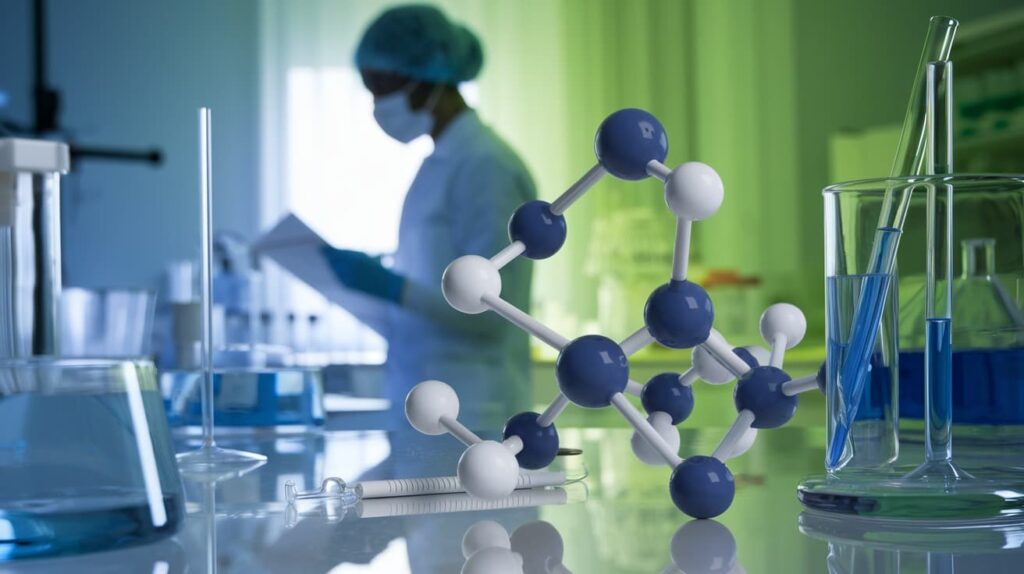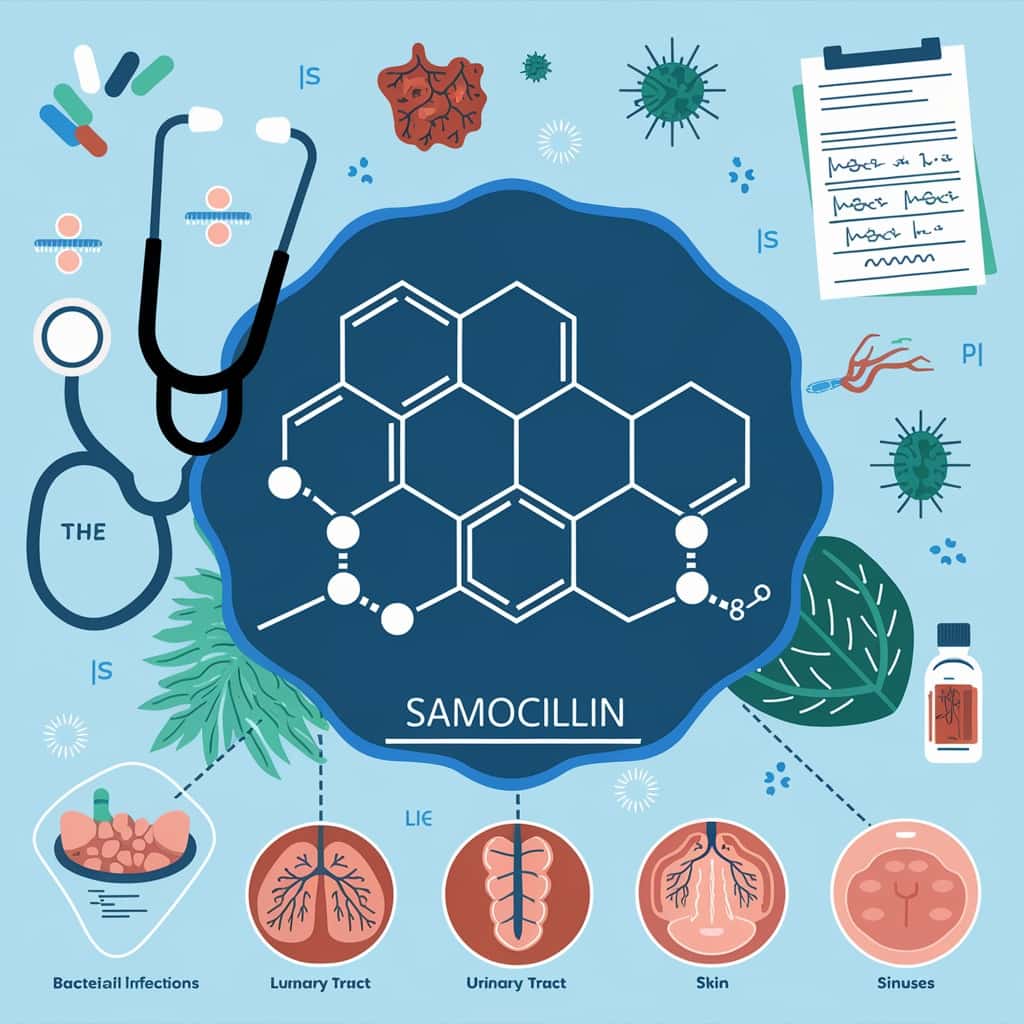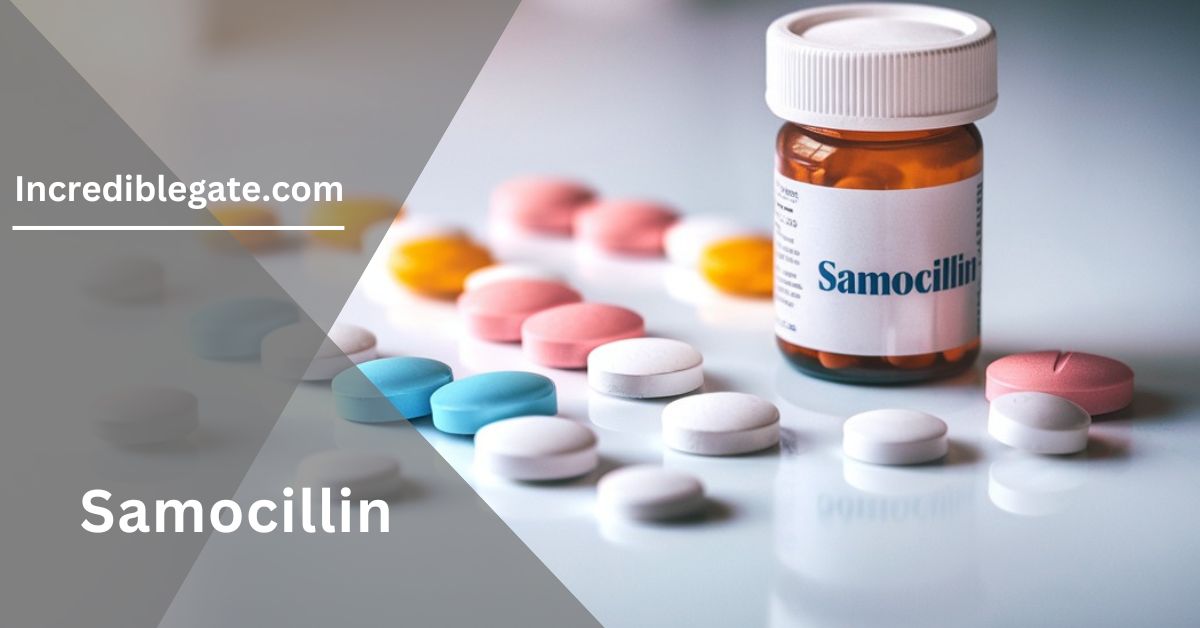Samocillin is a powerful, broad-spectrum antibiotic belonging to the penicillin group. Known for its effectiveness in treating many bacterial infections, Samocillin has become a crucial medication in the medical world. Derived from penicillin, it has undergone modifications to enhance its therapeutic properties, improve resistance to stomach acid, and broaden its activity against various bacterial strains.
This article offers an in-depth look into Samocillin, including its history, chemical composition, medical uses, pharmacokinetics, potential side effects, and its future in antibiotic therapy.
What is Samocillin?
Samocillin, a penicillin-based antibiotic, is widely used in medicine because it works well against many bacterial infections. Its broad-spectrum action makes it a good choice for treating respiratory infections, urinary tract infections, skin problems, and sinus infections. It’s popular because it doesn’t often lead to antibiotic resistance like other drugs, making it a trusted option for doctors.
Additionally, it is easy to take and usually well-tolerated, with mild side effects for most patients. Its reliable performance helps speed recovery, allowing people to return to normal routines faster. it can be used for adults and children, making it versatile for different age groups.
History And Development Of Samocillin:
Samocillin was first developed in the mid-20th century as a modified penicillin derivative, originally discovered by Alexander Fleming in 1928. The introduction of penicillin marked a revolutionary medical breakthrough, and scientists sought to improve its therapeutic properties to treat a wider range of bacterial infections. Samocillin emerged as one of these advancements, specifically designed to enhance penicillin’s effectiveness and broaden its activity spectrum.
Over the years, Samocillin has undergone various modifications to improve its stability, absorption, and resistance to stomach acid, making it more effective for oral use. These enhancements have helped it maintain a crucial role in modern antibiotic therapy, paving the way for further innovations in antibiotic development and inspiring new approaches to tackle bacterial resistance.

Chemical Composition And Structure Of Samocillin:
Samocillin’s chemical composition is primarily based on its active ingredient, amoxicillin, which is a derivative of penicillin. The molecular structure of Samocillin features a beta-lactam ring, a characteristic component of penicillin antibiotics that is essential for their antibacterial activity. This beta-lactam ring enables Samocillin to interfere with bacterial cell wall synthesis, ultimately destroying bacterial cells.
Molecular Structure:
The molecular formula of Samocillin is C₁₆H₁₉N₃O₅S. The structural formula consists of a beta-lactam core attached to a thiazolidine ring and an amino side chain. The presence of the thiazolidine ring enhances its ability to penetrate bacterial cell walls, while the side chain modifications improve its effectiveness against a broader range of bacteria.
Active Ingredients and Modifications:
The primary active ingredient in Samocillin is amoxicillin, which inhibits the synthesis of bacterial cell walls. This action disrupts the integrity of the bacterial cell wall, leading to cell lysis and death. Over time, Samocillin has been chemically modified from its penicillin origins to enhance its stability and bioavailability. These modifications have included alterations to the beta-lactam ring and side chains, which help increase its resistance to stomach acid and improve its absorption when taken orally.
Pharmacokinetics:
Samocillin is well-absorbed in the gastrointestinal tract, with peak plasma concentrations typically reached within one to two hours after oral administration. Its distribution throughout the body, including into various tissues and fluids, effectively treats infections in different body areas. The drug is primarily excreted through the kidneys, an important consideration for dosing in patients with renal impairment.
How Samocillin Works In The Body?
Samocillin acts by disrupting the synthesis of bacterial cell walls. The beta-lactam ring binds to enzymes essential for forming the cell wall, leading to cell lysis and death. This process eliminates the bacteria and supports the body’s immune system in clearing the remaining infection more efficiently.
By breaking down the protective outer layer of the bacteria, Samocillin makes it easier for the immune system to recognize and fight off the infection. As a result, patients often experience quicker recovery times. Additionally, this antibiotic is effective against a wide range of bacteria, making it a versatile treatment option for various infections.
Medical Applications Of Samocillin – Discover Its Benefits!
Respiratory Tract Infections:
Samocillin is frequently prescribed for respiratory tract infections, such as bronchitis and pneumonia. These conditions are often caused by bacteria, and Samocillin helps to eliminate the pathogens, leading to a quicker recovery. Its ability to penetrate lung tissues is particularly effective for treating these infections.
Urinary Tract Infections (UTIs):
Urinary tract infections, including cystitis and pyelonephritis, are common conditions that Samocillin effectively treats. Targeting the bacteria responsible for the infection helps relieve symptoms like painful urination and frequent urges to urinate. Its high absorption in the urinary tract further enhances its effectiveness against these infections.
Skin Infections:
Samocillin also treats various skin infections, such as impetigo and cellulitis. These conditions, often caused by staphylococcal or streptococcal bacteria, can lead to painful and swollen areas on the skin. Samocillin helps clear the infection, allowing the skin to heal more rapidly.
Bacterial Sinusitis:
Bacterial sinusitis, characterized by inflammation of the sinuses due to bacterial infection, can cause significant discomfort and congestion. Samocillin effectively treats this condition by targeting the bacteria and alleviating symptoms like nasal congestion, facial pain, and pressure.
Ear Infections (Otitis Media):
Samocillin is commonly prescribed for acute otitis media, particularly in children. This condition involves the middle ear infection, which can cause pain and irritability. Samocillin helps reduce the infection and provides relief, allowing children to recover quickly.
Gastrointestinal Infections:
In some cases, Samocillin can treat gastrointestinal infections caused by specific bacterial strains. Targeting these pathogens helps alleviate symptoms such as diarrhea and abdominal pain. By effectively eliminating the bacteria responsible for the infection, Samocillin promotes faster recovery and reduces the risk of complications associated with gastrointestinal issues.

Dosage and Administration Guidelines for Samocillin – Need To Know!
Samocillin is typically administered orally, in tablet or suspension form. The dosage varies based on factors such as the type and severity of the infection, the patient’s age, and overall health. Standard dosing guidelines include:
- Adults: 250-500 mg every 8 hours.
- Children: Dosing is often based on body weight, ranging from 20-40 mg/kg per day, divided into multiple doses.
- Special Considerations: Dosage adjustments may be necessary for patients with kidney impairment or severe infections.
Side Effects And Precautions Of Samocillin – Dont Miss Out!
Common Side Effects:
While Samocillin is generally well-tolerated, some patients may experience:
- Nausea and Vomiting: Can be mitigated by taking the medication with food.
- Diarrhea: Usually mild, but if severe, it may require discontinuation.
- Headaches and Dizziness: Staying hydrated and resting can help alleviate these symptoms.
- Fatigue: This may improve as the body adjusts to the medication.
Rare But Serious Reactions:
Some rare but potentially serious side effects include:
- Severe Allergic Reactions (Anaphylaxis): Requires immediate medical attention.
- Antibiotic-Associated Colitis: This condition is characterized by colon inflammation due to an overgrowth of certain bacteria, such as Clostridium difficile. Symptoms may include severe diarrhea, abdominal pain, and fever, necessitating prompt treatment to manage complications.
- Stevens-Johnson Syndrome: A rare but severe skin reaction.
- Liver Damage: Regular monitoring may be needed for patients on long-term therapy.
Who Should Avoid Samocillin?
Certain individuals should avoid taking Samocillin to prevent serious complications. Anyone with a known allergy to penicillin or other beta-lactam antibiotics should not use this medication, as it can lead to severe allergic reactions. Additionally, people with a history of anaphylaxis or serious allergic responses should consult their healthcare provider before starting Samocillin.
Those with significant kidney problems may also need to avoid this antibiotic or require a dosage adjustment, as it can affect kidney function. Pregnant or breastfeeding individuals should only take Samocillin if prescribed by a healthcare professional, ensuring that the benefits outweigh any potential risks. Always discuss your medical history with your doctor to determine if Samocillin is appropriate.
Comparative Analysis Of Samocillin And Other Antibiotics:
- Spectrum of Activity: Samocillin has a broader spectrum of activity than traditional penicillins like penicillin G or V. This means it can effectively treat a wider variety of bacterial infections, making it a preferred choice for many clinicians.
- Resistance Profiles: Compared to other antibiotics, Samocillin generally has a lower incidence of resistance among common pathogens. However, it is still essential to monitor emerging resistance patterns to maintain its effectiveness in clinical settings.
- Oral Bioavailability: Samocillin is better tolerated and more effective when taken orally than older penicillins. Its chemical modifications enhance its stability in the stomach’s acidic environment, leading to improved absorption and efficacy.
- Side Effects: While all antibiotics can have side effects, Samocillin is often well-tolerated. However, the side effects may differ in severity and frequency compared to other antibiotics like tetracyclines or macrolides, which can cause more significant gastrointestinal disturbances.
- Usage in Special Populations: Samocillin is generally considered safe for use in pregnant and breastfeeding women when prescribed. However, some alternative antibiotics may have stricter contraindications, making Samocillin a more suitable option in these cases. Always consult a healthcare provider to determine the best choice based on individual health needs and circumstances.
Future Directions And Research On Samocillin:
Future research on Samocillin focuses on enhancing its effectiveness and addressing the challenge of antibiotic resistance. Scientists are exploring new formulations that improve how the drug works in the body and finding ways to combine Samocillin with other medications to fight resistant bacteria. Researchers are also investigating its potential use in treating different types of infections, including those caused by less common bacteria.
Additionally, studies aim to understand how genetic factors affect how patients respond to Samocillin, leading to more personalized treatment options. By continuing to study Samocillin, the medical community hopes to ensure it remains a valuable tool in fighting bacterial infections for years.
Frequently Asked Questions:
How should Samocillin be taken?
Samocillin is typically taken orally in the form of tablets or a suspension. The dosage depends on the type and severity of the infection, as well as the patient’s age and health. Following the prescribed dosage and schedule is important to ensure effective treatment.
Can I take Samocillin with food?
Yes, taking Samocillin with food can help minimize gastrointestinal side effects like nausea. While the medication absorption is generally good, having it with food can make it more comfortable for some patients. Always follow your healthcare provider’s recommendations regarding food intake with medications.
What should I do if I miss a dose of Samocillin?
If you miss a dose of Samocillin, take it as soon as you remember. However, if it’s almost time for your next dose, skip the missed dose and resume your regular schedule. Do not double up on doses to make up for a missed one, as this can increase the risk of side effects.
Are there any dietary restrictions while on Samocillin?
There are no strict dietary restrictions when taking Samocillin, but taking it with food can help reduce gastrointestinal discomfort. However, high-fat meals might affect the absorption slightly. It’s always best to follow the specific advice of your healthcare provider regarding diet during treatment.
What happens if I overdose on Samocillin?
An overdose of Samocillin can lead to symptoms such as severe nausea, vomiting, diarrhea, and possibly more serious reactions. If you suspect an overdose, it’s critical to seek medical attention immediately. Always store medications safely and out of reach of children to prevent accidental ingestion.
Conclusion:
Samocillin is significant in modern medicine due to its broad-spectrum efficacy in treating bacterial infections. Its development from penicillin and the continuous advancements in its formulation have allowed it to remain a vital tool in combating bacterial diseases.
With ongoing research and innovations, Samocillin’s future promises enhanced therapeutic applications and improved treatment outcomes for patients worldwide.
You Have To Read:

